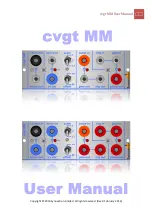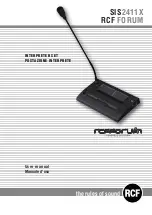
Program P4: String 4-7: String Pitch
255
Fingered
[Off, On]
This parameter allows you to control Portamento
through your playing style. When it’s enabled, playing
legato will turn on Portamento, and playing detached
will turn it off again.
This option is only available when Portamento Enable
is turned on.
On (checked):
Turns on Fingered Portamento.
Off (unchecked):
Turns off Fingered Portamento.
Mode
[Constant Rate, Constant Time]
Constant Rate means that Portamento will always take
the same amount of time to glide a given distance in
pitch - for instance, one second per octave. Put another
way, gliding several octaves will take much longer
than gliding a half-step.
Constant Time means that Portamento will always take
the same amount of time to glide from one note to
another, regardless of the difference in pitch. This is
especially useful when playing chords, since it ensures
that each note in the chord will end its glide at the
same time.
Time
[000...127]
This controls the portamento time. Higher values
mean longer times, for slower changes in pitch. When
Time
is set to
0
, the pitch will be reached instantly–just
as if Portamento
Enable
was turned
Off
.
AMS
[List of AMS Sources]
This selects an AMS source to control the
Portamento
Time
. For a list of AMS sources, see “AMS (Alternate
Modulation Source) List” on page 967.
The modulation occurs only at note-on. This means
that you can change the time for the
next
pitch glide,
but you can’t change any glides which are already in
progress.
Intensity
[-127…+127]
This controls the depth and direction of the
Portamento Time
AMS modulation.
4-7c: LFO
LFO Select
[LFO 1, LFO 2, LFO 3, LFO 4,
Common LFO]
This selects an LFO to modulate the String’s pitch.
The
LFO Intensity
,
JS+ Y Intensity
, and
AMS
are all
summed together to produce the final amount of LFO
pitch modulation.
LFO Intensity
[–48.00…+48.00]
This controls the initial effect of the LFO on the pitch,
in semitones, before any JS+Y or AMS modulation.
Negative (–)
settings will invert the phase of the LFO.
Both the String and PCM Pitch LFO Intensities are
scaled by MIDI CC#77.
JS+Y Intensity
[–48.00…+48.00]
Moving the joystick “up” from the center detent
position, away from yourself, produces the JS+Y
controller. You can use this to scale the amount of the
LFO applied to the pitch. This parameter sets the
maximum amount of LFO modulation added by JS+Y,
in semitones.
As this value is
increased
, moving the joystick in the
+Y direction will cause the LFO to produce deeper
pitch modulation.
Negative (–)
settings will invert the phase of the LFO.
You can also use this to reduce the initial amount of the
LFO, as set by
LFO1 Intensity
, above.
AMS
[AMS Sources]
This selects an AMS modulation source to scale the
amount of the LFO applied to pitch.
For a list of AMS sources, see “AMS (Alternate
Modulation Source) List” on page 967.
Intensity
[–48.00…+48.00]
This controls the depth and direction of the LFO AMS
modulation, in semitones.
4-7d: Pitch EG
EG Select
[Filter EG 1, Pitch EG 2,
EG 3, EG 4, Amp EG
This selects an EG to modulate the String pitch.
There are four assignable EGs, in addition to the Amp
EG. Each of these can be used as a modulation source
to control a wide variety of parameters.
In the midst of all this flexibility, we thought it would
also be good to provide a little structure. With this in
mind, EG 1 is named EG 1 (Filter) and EG 2 is labeled
EG 2 (Pitch).
Please take these names as suggestions, rather than
restrictions. If you like, you’re free to use these EGs to
control any EG or AMS destination, or to use other EGs
to control Filter Frequency and Pitch.
Intensity
[-48.00…+48.00]
This controls the initial effect of the Pitch EG on the
String, in half-steps, before any AMS modulation.
The Pitch EG’s shape can swing all the way from +99 to
-99. When the Intensity is set to a
positive (+)
value,
positive values from the EG raise the pitch, and
negative values lower the pitch.
When the Intensity is set to a
negative (-)
value, the
effect of the EG is reversed; positive EG values mean
lower
pitches, and negative EG values mean
higher
pitches.
AMS
[AMS Sources]
This selects an AMS modulation source to scale the
amount of the Pitch EG applied to the String.
For a list of AMS sources, see “AMS (Alternate
Modulation Source) List” on page 967.
Intensity
[-48.00…+48.00]
This controls the depth and direction of the pitch EG
AMS modulation. The AMS modulation and the initial
Intensity are added together to determine the Pitch
EG’s final effect.
Содержание Electronic Keyboard
Страница 1: ...Parameter Guide Parameter Guide ...
Страница 2: ......
Страница 180: ...Program mode EXi 170 ...
Страница 290: ...EXi STR 1 Plucked String 280 ...
Страница 572: ...Sequencer mode 562 ...
Страница 700: ...Global mode 690 ...
Страница 751: ...Insert Effects IFX1 IFX12 Routing 741 Fig 2 3a Fig 2 3b ...
Страница 902: ...Effect Guide 892 ...
















































